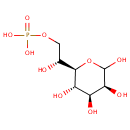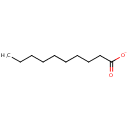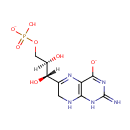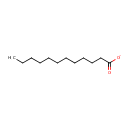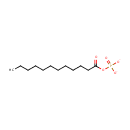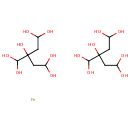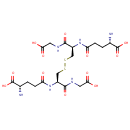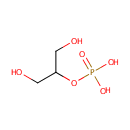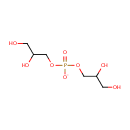
Search Results for compounds
Searching compounds for
returned 4373 results.
D-Glycero-D-manno-heptose 7-phosphate (PAMDB001609)
IUPAC:
[(2R)-2-hydroxy-2-[(2R,3S,4S,5S)-3,4,5,6-tetrahydroxyoxan-2-yl]ethoxy]phosphonic acid
CAS: Not Available
Description: D-glycero-D-manno-heptose 7-phosphate is a member of the chemical class known as Hexoses. These are monosaccharides in which the sugar unit is a hexose.
Decanoate (N-C10:0) (PAMDB001612)
IUPAC:
decanoate
CAS: Not Available
Description: Decanoate (n-c10:0) belongs to the class of Carboxylic Acid Salts. These are ionic derivatives of carboxylic acid. (inferred from compound structure)Decanoate (n-c10:0) is invovled in Fatty acid biosynthesis. (KEGG)Decanoic acid, or capric acid, is a saturated fatty acid. Its formula is CH3(CH2)8COOH. Salts and esters of decanoic acid are called decanoates. The term capric acid arises from the Latin capric which pertains to goats due to their olfactory similarities. Capric acid occurs naturally in coconut oil and palm kernel oil, as well as in the milk of various mammals and to a lesser extent in other animal fats. It is used in organic synthesis and industrially in the manufacture of perfumes, lubricants, greases, rubber, dyes, plastics, food additives and pharmaceuticals. Two other acids are named after goats: caproic (C6) and caprylic (C8). Along with decanoic acid, these total 15% in goat milk fat. (WikiPedia)
Dihydroneopterin monophosphate (PAMDB001614)
IUPAC:
6-[(1S,2R)-3-(hydrogen phosphonatooxy)-1,2-dihydroxypropyl]-2-imino-1,2,7,8-tetrahydropteridin-4-olate
CAS: Not Available
Description: Dihydroneopterin monophosphate is a member of the chemical class known as Biopterins and Derivatives. These are coenzymes containing a 2-amino-pteridine-4-one derivative. Dihdroneopterin monophosphate is an intermediate involved in tetrahydrofolate biosynthesis and salvage in Pseudomonas aeruginosa. It is converted to 7,8-dihydroneopterin through an unknown phosphorylase enzyme.
Dodecanoate (N-C12:0) (PAMDB001617)
IUPAC:
dodecanoate
CAS: Not Available
Description: Dodecanoate (n-c12:0) belongs to the class of Carboxylic Acid Salts. These are ionic derivatives of carboxylic acid. (inferred from compound structure) Dodecanoic acid, also known as lauric acid is a saturated fatty acid with a 12-carbon atom chain, thus falling into the medium chain fatty acids. It is a white, powdery solid with a faint odor of bay oil or soap. (Wikipedia) In plants and bacteria like Pseudomonas aeruginosa, dodecanoate is a by-product in one palmitate biosynthesis pathway. (EcoCyc)
Dodecanoly-phosphate (n-C12:0) (PAMDB001618)
IUPAC:
(dodecanoyloxy)phosphonate
CAS: Not Available
Description: Dodecanoyl-phosphate (n-c12:0) belongs to the class of Acyl Phosphates. These are organic compounds containing the functional group -CO-P(O)(O)OH. (inferred from compound structure)
Fe(III)dicitrate (PAMDB001621)
IUPAC:
bis(3-(dihydroxymethyl)pentane-1,1,3,5,5-pentol) iron
CAS: Not Available
Description: Fe(iii)dicitrate is the complex formed between iron(III) and citrate. It is a substrate for the Pseudomonas aeruginosa transport protein known as FecA. FecA is the outer membrane receptor protein in the Fe3+ dicitrate transport system.
Glutathione disulfide (PAMDB001629)
IUPAC:
(2S)-2-amino-4-{[(1R)-2-{[(2R)-2-[(4S)-4-amino-4-carboxybutanamido]-2-[(carboxymethyl)carbamoyl]ethyl]disulfanyl}-1-[(carboxymethyl)carbamoyl]ethyl]carbamoyl}butanoic acid
CAS: 27025-41-8
Description: Glutathione (GSH) is a tripeptide with a gamma peptide linkage between the amine group of cysteine (which is attached by normal peptide linkage to a glycine) and the carboxyl group of the glutamate side-chain. It is an antioxidant, preventing damage to important cellular components caused by reactive oxygen species such as free radicals and peroxides. Glutathione is a cofactor for the enzyme glutathione peroxidase. Glutathione is also needed for the detoxification of methylglyoxal, a toxin produced as a by-product of metabolism. This detoxification reaction is carried out by the glyoxalase system. Glyoxalase (EC 4.4.1.5) catalyzes the conversion of methylglyoxal and reduced glutathione to S-D-Lactoyl-glutathione. Glyoxalase (EC 3.1.2.6) catalyzes the hydrolysis of S-D-Lactoyl-glutathione to glutathione and D-lactate.; Glutathione disulfide (GSSG) is a disulfide derived from two glutathione molecules.
Glycerol 2-phosphate (PAMDB001630)
IUPAC:
[(1,3-dihydroxypropan-2-yl)oxy]phosphonic acid
CAS: 17181-54-3
Description: Glycerol-2-phosphate is a component of glycerolipid metabolism. It is formed in minor quanitites, as the alpha glycerophosphorate is preferentially formed in this manner. Also used as a biological buffer (Sigma-Aldrich).
Glycerophosphoglycerol (PAMDB001631)
IUPAC:
3-[(2,3-dihydroxypropyl phosphonato)oxy]propane-1,2-diol
CAS: Not Available
Description: Glycerophosphoglycerol is a substrate for glycerol and phosphate salvage in Pseudomonas aeruginosa. Pseudomonas aeruginosa possesses two systems the salvage of glycerophosphoryl diesters, the Glp system and the Ugp system. In the Glp system, the glpQ gene encodes a periplasmic glycerophosphoryl diester phosphodiesterase (periplasmic GDP) which hydrolyzes deacylated phospholipids to an alcohol and sn-glycerol-3-phosphate. The latter is then transported into the cell by the GlpT transporter. Periplasmic GDP is specific for the glycerophospho- moiety of the substrate, while the alcohol can be any one of several alcohols. This provides the cell with the capability of channeling a wide variety of glycerophosphodiesters into the glpQT-encoded dissimilatory system. In the Ugp system the diesters are hydrolyzed during transport at the cytoplasmic side of the inner membrane to sn-glycerol-3-phosphate and an alcohol by a cytoplasmic GDP, an enzyme encoded by the ugpQ gene. The Ugp system is induced when the cells are starved for inorganic phospate, which is generates phosphate by the system. In Pseudomonas aeruginosa sn-glycerol-3-phosphate can be further metabolized to dihydroxyacetone phosphate by either of two membrane-bound enzymes, depending on the growth conditions. The presumed role of this process is the salvage of glycerol and glycerol phosphates generated by the breakdown of phospholipids and triacylglycerol.
Hydrogen ion (PAMDB001633)
IUPAC:
hydron
CAS: Not Available
Description: Hydrogen ion is recommended by IUPAC as a general term for all ions of hydrogen and its isotopes. Depending on the charge of the ion, two different classes can be distinguished: positively charged ions and negatively charged ions. Under aqueous conditions found in biochemistry, hydrogen ions exist as the hydrated form hydronium, H3O+, but these are often still referred to as hydrogen ions or even protons by biochemists. (WikiPedia)
